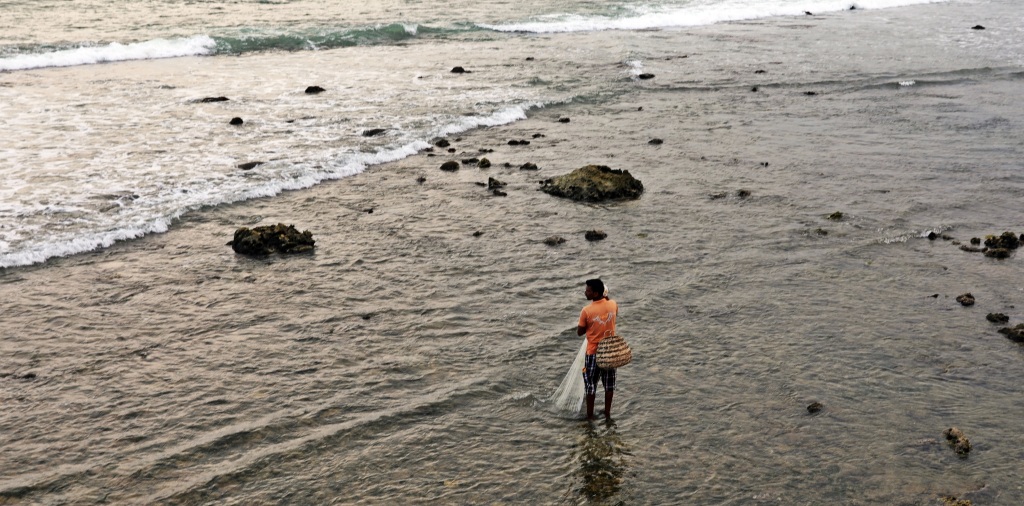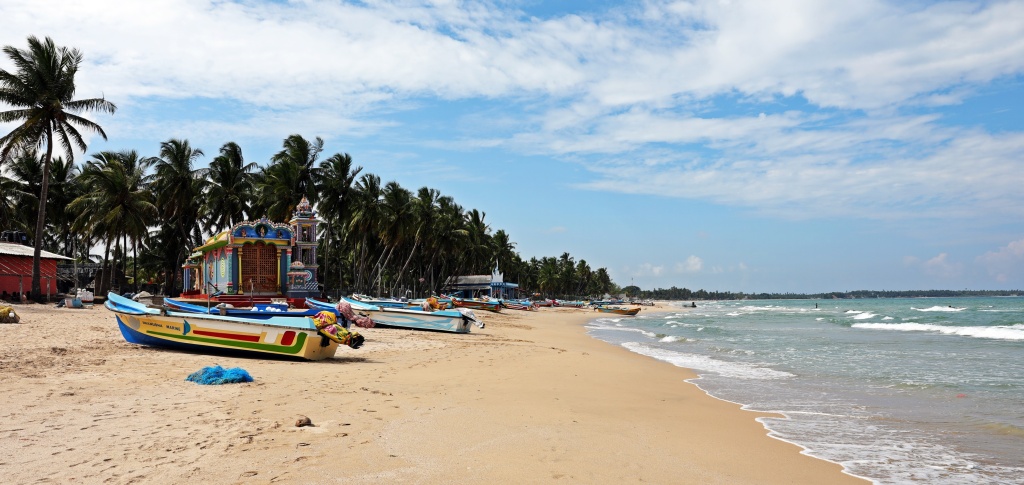The east coast of Sri Lanka has a long coast line with beach, after beach, after beach. They are quite different, however, from the idyllic beaches on the south coast.
Arugam Bay is a popular beach town on the east coast. It is usually a busy tourist spot as its one of the best places for surfing in Sri Lanka. Some list Arugam Bay as one of the best surfing spots in the world. We were there in February which is off-season, so for us it was a lazy town with not much to do but hang out on the beach and go for good Americano coffee. Even during off-season, the waves were quite high. We walked along the beach to a surfing site called The Point. From here you can see the power of the ocean as the large waves crash down hard on the beach. During surfing season, the waves can be up to 8 feet high.
Arugam Bay was one of the hardest hit areas in Sri Lanka during the 2004 Tsunami. The town was flattened, and thousands of people died. It’s a conservative Muslim community and apparently most of those who died were girls as they didn’t know how to swim.











One day when we were walking on the beach we met the owner of Mr. Fisherman Restaurant. He told us he had fresh elephant tuna in his restaurant for dinner that night. Not knowing what elephant tuna was Maggie asked him if it had a big snout like an elephant. Mr. Fisherman laughed and laughed and slowly repeated ‘Yellow Fin’! Even funnier, when we looked at his reviews on the internet, someone else gave the same story about elephant tuna, but never did figure out that he said yellow fin!
It was the end of monsoon season when we were in Arugam Bay so there was plenty of water in the many lagoons. We rented one-gear, brake-less bicycles and rode around the countryside. There were of course many rice fields, but also plenty of small and large lagoons with many different types of water birds, eagles and turtles. We saw at least 25 of the beautiful White-Breasted Kingfishers. On the way back to town Richard was amazed to watch a man dressed in rubber boots and a helmet working on a live power transformer.











North of Arugam Bay, the east coast beach towns and their beaches are quite different than the tranquil ones in the south. There are more Tamil Hindu towns along the east coast and it felt like we were back in India. There were women in sarees and Hindu temples but also disorganized ramshackle towns, street cows, and garbage all over the streets and beaches. The south beaches are generally clean from garbage and debris, the east however is a different story. We found everything from plastic water bottles to children’s toys and cow dung along the beaches and on the streets in town. The music is also very different in this part of Sri Lanka. In southern Sri Lanka they listen to reggae and calypso-style music with steel drums and a fast dance beat. The band members have dreadlocks or corn-rowed hair. In the Tamil area we heard the typical sounds of Bollywood including many love songs and duets. The accompanying videos had Bollywood style dancers.
Kalkudah and Pasikudah beaches are near the start of the Tamil populated north. They are separated from each other by a narrow rocky point. Kalkudah is a long, white sand beach with gentle waves and no people. It could have been perfect. In the mornings however, our beach was covered in cow dung from the street cows. As we walked along the beach, we couldn’t help but notice the large amounts of garbage strewn about the sand. On the other side of the rocky point, Pasikudah beach is much busier with large resorts and plenty of beach goers. It’s a popular beach for Sri Lankans and western tourists but we can’t figure out why. The sand on this side of peninsula is course and full of broken coral and a lot of garbage. It’s not nearly as nice as Kalkudah, just around the corner. In the off-season both were very quiet and the only two restaurants in town were empty.












Batticaloa is a large town on the east coast with a small fort. It has a similar history to most of the forts in Sri Lanka. Batticaloa Fort was initially built by the Portuguese, rebuilt by the Dutch, taken over by the British and now used the the Sinhalese government. The thick stone fortress wall is still fully intact and has a small moat that is lively with water birds, fish and fishing birds like kingfishers. The colonial buildings inside the fort walls are used as local government offices, but the buildings are were not in good condition.






Further north, the large city of Trincomalee (called Trinco) also has a fort that was built during the spice route trading times. Fort Frederick is situated on the narrow neck of a small cape. Most of the fort wall is still standing strong against the rough ocean waters on either side. Inside the fort it is quite different from others we’ve seen. It is still used by the Sri Lankan Navy but has a park-like setting. There are grass yards, herds of spotted deer, peacocks and a lovely tree-lined street running through the middle. Many of the original Dutch buildings are being used by the navy.




On a hill at the end of the cape is Koneswaram Temple. It is an important Hindu temple and is built on a site where Hindu temples have stood since prehistoric times. There is walkway along the cliffs below the temple that lead to an ancient cave temple. Koneswaram Temple is dedicated to Shiva so there are many lingams and Nandi-the-bull statues on the temple grounds. There’s an interesting legend that goes along with the site. In the 4th century BC, King Ravana prayed to receive a Shiva Lingam at this site. When he didn’t receive one, he got angry and used his sword to cut a cleft in the steep rocky cliffs. Today that cleft is called Ravana Cut and is an awesome rocky gap with the sea crashing into its base. Further along the cove is a statue of the King Ravana on the side of the cliff.
There were hundreds of small wooden crates strung along the trees and fences around the temple. Local women believe that praying at this temple and hanging these ‘cradles’ will help them conceive. The Temple was under construction when we were there, but its position at the end of the tall cape allowed for beautiful views of the coastline and Trinco’s beaches.





The beaches north of Trinco, Uppuveli and Nilaveli are similar to others we visited on the east coast. They are long white sand beaches but are littered with garbage. They have so much potential and are touted as being perfect beaches, but with all the garbage it was difficult to see the serenity. It was also quite stormy when we were there. The water was very rough, with high waves. It made us remember the words of George Costanza; ‘the sea was angry that day my friends’¹.






Both beaches have many fishing boats, but on these beaches, most of them are motorized. We had fun watching the fishermen race out into the ocean in their motor boats, flying over the wild waves. It was even more fun watching them do the same coming back in to shore, their motor boats landing on the sand 5m beyond the water’s edge. We also watched them bring in their nets each day. The nets were dropped far from shore by the boats and then at least 50 men worked together to pull in both ends of one net. One time the net was full of small to medium fish, but another it was almost empty. Both times we saw many small fish caught in the net that would not be sold. It was sad to see such a waste. It made us realize how bad net fishing really is.




¹. George Costanza (Jason Alexander), Seinfeld, Season 5: The Marine Biologist
Coming up next: Sacred cities of Sri Lanka
For extra pics from this trip go to Gallery/Sri Lanka. For extra pictures from other blogs go to Gallery at monkeystale.ca
To read about more of our adventures go to Destinations.
If you like what you read, please comment or share it using the links below.
The Yellowfin misunderstanding and George Costanza quote are both priceless (I remember that episode)! The coast does look lovely; such a shame about the litter. I love your fishermen photos. We will not have time for these east coast beaches but sounds like from an idyllic beach perspective, the south is the place to go.
LikeLiked by 1 person
Thanks! The east coast looks great from a far but up close they were disappointing. Arugam though was still fairly clean. Mr Fisherman was so funny and especially when we saw it on Tripadvisor!
LikeLiked by 1 person
Ah you are bringing back such good memories guys. Trincomalee and those beaches just north were where we ended up on our journey across Sri Lanka west to east a few years ago. Trinco was so humid for a coastal town. We don’t actually remember any garbage problem on the beaches but the rough waves were great fun to play in – maybe we got lucky and the wind had blown the garbage away! Just looking at your photos brings it all back. We’ll be back one day to see more…
LikeLiked by 1 person
Thank you, this is one country that we would consider returning to as well. Glad we brought back good memories!!
LikeLike
Brought back good memories for me too!
LikeLiked by 1 person
Wow super article 🙂 you are awesome and your way of telling is so magnificent. Thanks a lot dear for sharing such a useful Info on your Page. Good Luck
LikeLiked by 1 person
Thank you so much, I really appreciate your kind words 😊
LikeLike
Muchas gracias. ?Como puedo iniciar sesion?
LikeLike
Muchas gracias. ?Como puedo iniciar sesion?
LikeLike